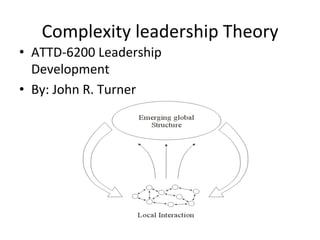
Complex ldrtheory
- 1. Complexity leadership Theory • ATTD-‐6200 Leadership Development • By: John R. Turner
- 2. Complexity Leadership Theory IntroducCon Complexity Theory (CT) Complexity Leadership Theory (CLT) CLT CharacterisCcs CorrelaCon AggregaCon AutocatalyCc Mechanism Nonlinear Emergence Advantages & Disadvantages Conclusion
- 3. IntroducCon • In an IBM research of more than 1,500 CEO’s Howard Tollit idenCfied as on of the significant findings: • “Complexity has overtaken change as the main challenge facing CEOs across the globe – and more than half of UK & Irish CEOs doubt their ability to manage it (the porporCon’s even higher worldwide)” (management today, 2010).
- 4. IntroducCon • Manville and Ober (2003) idenCfied that “We’re in a knowledge economy, but our managerial and governance systems are stuck in the Industrial Era. It’s Cme for a whole new model” (as cited in Uhl-‐Bien, Marion, & McKelvy, 2007, p. 298).
- 5. Complexity Theory • CLT is derived from CT • CT “concerns the descripCon and predicCon of systems that exhibit complex changing behavior at the macroscopic level, emerging from the collecCve acCons of many interacCng components” (Mitchell, 2009, p. 15). – The Brain; interacCng neurons – The WWW; Network of individual players
- 6. Complexity Theory • “Complexity theorists are interested in understanding how the interacCons of people in organizaCons lead to the creaCon of paberns of behavior, which in turn shape organizaConal strategies, power structures, and networks of relaConships” (Ardichvili & Manderscheid, 2008, p. 624).
- 7. Complexity Leadership Theory • CLT funcCons to create “condiCons that enable the interacCons through which the behaviors and direcCon of organizaConal systems emerge. Leaders provide control by influencing organizaConal behavior through managing networks and interacCons” (Marion & Uhl-‐Bien, 2001, p. 406).
- 8. CharacterisCcs of CLT • CorrelaCon • AggregaCon • AutocatalyCc InteracCon • Nonlinear Emergence
- 9. CorrelaCon • Shared interest among agents (people) • Common beliefs • Similar world-‐views • Type of bonding process between agents • Fosters integraCon among agents • Forms aggregates (networks)
- 10. AggregaCon • Changes among agents • Changes are ogen caused by interacCons and correlaCon between agents and networks of agents • CT sees small changes, at the micro-‐level, leading to large changes, at the macro-‐level • Self-‐organizing
- 11. AutocatalyCc InteracCon • The state where different units (agents or departments) interact • InteracCon cannot be predetermined by leadership • InteracCon must be enabled by leaders • Has a moderaCng effect • Self-‐generaCng system
- 12. Nonlinear Emergence • Nonlinear (inter-‐ & intra-‐department, internal and external of organizaCon) • Sudden and unpredictable change – InnovaCon – New technologies – Break into new markets • Structures evolve and reorganize – Similar to a network system • Bobom-‐up directed
- 13. Advantages / Disadvantages • Advantages – Self-‐organizing – less managerial funcCons • Disadvantages – OrganizaConal Culture Change • leaders have to release control • follower have more responsibiliCes – HR Challenge – PotenCal for Chaos
- 14. Conclusion • Through Complex Leadership Theory Leaders Should: – Create condiCons for innovaCon as opposed to creaCng the innovaCon – Drop seeds of innovaCon rather than mandaCng innovaCon plans – Create opportuniCes to interact rather than creaCng isolated and controlled work cubicles – Tend to networks – Catalyze more than they control (Marion & Uhl-‐Bien, 2001).
- 15. References Ardichvili, A. & Manderscheid (2008). Emerging pracCces in leadership development: An introducCon. Advances in Developing Human Resources, 10(5), 619-‐631. Management Today (2010, June 07). MT leadership visions: Capitalising on complexity. Retrieved from hbp://www.managemenboday.co.UK/news/1008266/mt-‐leadership-‐ visions-‐capitalising-‐complexity/ Marion, R. & Uhl-‐Bien, M. (2001). Leadership in complex organizaCons. The Leadership Quarterly, 12, 389-‐418. Retrieved from hbp:// www.elsevier.com/wps/find/journaldescripCon.cws_home/620221/ descripCon#descripCon Mitchell, M. (2009). Complexity: A guided tour. New York, NY: Oxford University Press. Uhl-‐Biewn, M., Marion, R., & McKelvey, B. (2007). Complexity leadership theory: Shiging leadership from the industrial age to the knowledge era. The Leadership Quarterly, 18, 298-‐318. doi: 10.1016/j.leaqua. 2007.04.002
